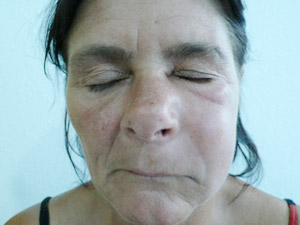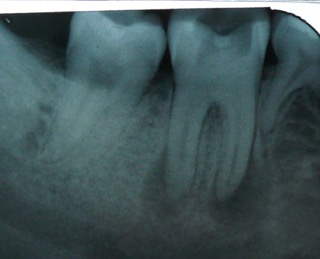Tooth Abscess
Treatment
There aren't many options. Tooth abscess treatment is dictated by what stage the infection has reached, how severe the infection is, and HOW MUCH PAIN you are in.
The first thing is to confirm that the pain really IS caused by a tooth abscess, and not something else. This might seem simple, BUT sometimes a tooth will be painful (or you have a swollen jaw) for OTHER reasons. AND IT"S NOT ALWAYS EASY to identify a tooth abscess.
Once we are SURE your pain and swelling are due to a dental abscess, the NEXT step is TREATMENT. Treatment will almost always include antibiotics as a first step. The next thing to decide is whether you want to keep the tooth or not. If the tooth is not really worth keeping, you might think about having it removed.
Maybe it's a back tooth with nothing to bite on. Maybe you have crowded teeth and it's been pushed out of line. Or it's got a big hole in it. There are many reasons why you might not want to keep the tooth.
 an abscess
an abscessIf that's the case, then the best tooth abscess treatment is to have the tooth removed. But make sure you follow all the instructions from the dentist. Otherwise you could end up with a Tooth Extraction infection or dry socket.
Tooth Abscess Treatment
The other option is to keep the tooth. The treatment you need in order to keep it depends on where the infection is coming from. There are two possibilities; either the nerve inside the tooth has died, leaving you with a dead tooth; or else you have an infection in the gum next to the tooth.
If you have a Dead Tooth, the only course of action is a root canal treatment. This will clean out all the bugs from inside the tooth, and seal it up to stop them getting back in! You can read more about root canal procedures at my page HERE.
If you are in a lot of pain, there is a very specific regime using over-the-counter products that provides a high level of pain control: take 600 mg of ibuprofen (3 standard Advil tablets) WITH 1000 mg acetaminophen (2 Extra-Strength Tylenol), and repeat every 6 hours as needed.
Don't exceed 3 grams of acetaminophen (6 Tylenol tabs) a day, and don't take it in combination with alcohol. Do not use this if you have a peptic ulcer, or liver/kidney disease. This should help your pain for now.
 abscess on the molar roots
abscess on the molar rootsIf the tooth is very painful to put any pressure on, this is caused by pus building up at the tip of the root, causing pressure. You will need Emergency Root Canal treatment. At the emergency appointment, the dentist will usually only do the simplest and quickest treatment to get rid of the pain.
He'll do just enough to get you comfortable. No marathon appointment at this stage!
He can make a little hole in the tooth to let the pus drain out. Relief from the pain is extremely rapid. Normally you would be given some antibiotics too, and asked to go back in a few days when things are more comfortable, to start the proper root canal therapy.
If you have a gum infection, it will either be around a tooth that has a gum flap, like a wisdom tooth that is halfway through, or else it will be caused by gum disease.
In both cases, a course of antibiotics will help to settle things down initially. The best antibiotic for a gum infection is usually metronidazole (Flagyl).
If you have a big swelling on the gum, it's caused by pus collecting under the surface. It's important to let the pus drain out, otherwise the infection can get really serious.
The dentist can numb the gum first, then make a small incision to let the pus out. This gets rid of the pressure build-up, and makes the gum feel a lot better within a few minutes.
If the infection is quite advanced, and you are having trouble swallowing or breathing, go to the nearest ER as quickly as possible. They can give high doses of antibiotics very quickly, and can also call in a specialist to see you if needed.
To sum up, tooth abscess treatment may be as quick and simple as getting the tooth out, or may involve antibiotics and several appointments for root canal treatment. It depends on the nature of the problem, and of course on what YOU want for your teeth!



